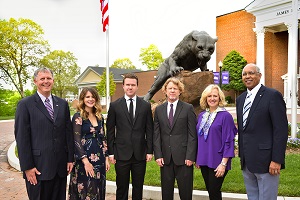Special to the Philanthropy Journal
By Lewis Faulk, Jurgen Willems, Jasmine McGinnis Johnson, and Amanda J. Stewart
In our personal lives, if we are asked about our social network we might think about the number of friends we have on Facebook, or followers on Twitter, or even the number of connections on LinkedIn. Yet, in our nonprofits, a social network must be conceived of more strategically – not as a measure of social media activity, but as the number of connections we share with peer nonprofits and even donors.
We know what this looks like in practice as it is not uncommon for nonprofits to partner with other nonprofits through informal collaborations or more formalized partnerships, such as coalitions. These network activities are played out publicly as organizations work together on mission-related activities. A less public way nonprofits forge these strategic network ties is through who serves on their boards.
In thinking about board members, we know boards serve two important functions: (1) monitoring and stewardship of the nonprofit’s resources and (2) attracting resources.[i] We also know that among the qualifications for board membership the nonprofit considers its board capital in terms of the human and relational capital of individual members.[ii] Human capital refers to the experience, expertise and reputation that individual members bring to their board service, whereas relational capital refers to the member’s ties to other organizations and stakeholders. In short, an ideal board member would be both skilled and connected.
What fruits do these board qualities bear? And do these connections of members help them fulfill their board responsibilities, specifically garnering resources for the nonprofit? In a study using a sample of nonprofits and foundations operating in the metropolitan Atlanta area, we set out to explore these questions.
We merged a listing of nonprofit and foundation board members with information about grants received by the nonprofits in the sample. We found a positive relationship between nonprofits being networked with other organizations through board members and success in obtaining grants. On average, we found that the relatively more networked a nonprofit is compared to other nonprofits, the more successful they were in obtaining grants, and more specifically, a board member also serving on a foundation’s board related to the grant success of the nonprofits.
So yes, connections of board members do relate to the nonprofit’s success in garnering resources. With this positive relationship, it is not just about who is on a nonprofit’s board, but also about who these members know. This finding offers guidance to nonprofits that their efforts in recruiting connected individuals to serve on their board may bear financial fruits for their nonprofit.
Of course in stating our findings, we offer appropriate cautions that these results are reflective of correlations, and not causes. We also base our findings on average relationships so that there can be substantial variation from case to case. And we do recognize that network ties of board members are but one variable in a complex explanation of what contributes to grant success. But yet these results are encouraging in describing that the connections of a nonprofit board members are helpful to a nonprofit’s success in garnering needed resources.
Caution is also offered in interpreting what do these network connections between board members mean in practical terms. We do not conceive of these connections as simply offering a competitive advantage to prioritize a funding request, but instead conceive that they may offer a comparative advantage. Connections create familiarity, recognition, and even trust –all of which prove helpful in increasingly competitive grant markets.
About this research: Based on a 2015 paper published in Public Management Review, entitled “Network Connections and Competitively Awarded Funding: The impacts of board network structures and status interlocks on nonprofit organizations’ foundation grant acquisition.”
Lewis Faulk is an assistant professor in the Department of Public Administration and Policy in the School of Public Affairs at American University. His research focuses on competition in the sector for financial resources, foundation grant-making, nonprofit workforce issues, and factors that influence organizational capacity and financial health.
Jurgen Willems is an Associate Professor of Business Administration, esp. Public Management at the Universität Hamburg. His research focuses on nonprofit management, volunteer resource management, and organizational governance.
Jasmine McGinnis Johnson is an Assistant Professor in the Trachtenberg School of Public Policy & Administration at The George Washington University. Her research focuses on the distribution of grants from philanthropic foundations to nonprofits organizations and the process by which these funds are allocated.
Amanda J. Stewart is an Assistant Professor in the School of Public and International Affairs at North Carolina State University. Her research focuses on nonprofit management, executive turnover, and foundation grantmaking.
[i] Callen, J. L., Klein, A. and Tinkelman, D. (2010) ‘The contextual impact of nonprofit board composition and structure on organizational performance: Agency and resource dependence perspectives’. Voluntas: International Journal of Voluntary and Nonprofit Organizations, 21:1 pp101-125.
Padanyi, P., and B. Gainer. (2003) ‘Peer reputation in the nonprofit sector: Its role in nonprofit sector management’. Corporate Reputation Review, 6:3 pp252-265.
Rindova, V. P., Pollock, T.G., and Hayward, M. (2006) ‘Celebrity firms: The social construction of market popularity’. Academy of Management Review, 31:1 pp50-71.
[ii] Pfeffer, J., and Salancik, G. R. (2003) The external control of organizations: a resource dependence perspective, Stanford, CA: Stanford Business Books.
Stone, M. M., and Ostrower, F. (2007) ‘Acting in the public interest? Another look at research on nonprofit governance’. Nonprofit and Voluntary Sector Quarterly, 36:3 pp416-438.
Miller-Millesen, J. L. (2003) ‘Understanding the behavior of nonprofit boards of directors: A theory-based approach’. Nonprofit and Voluntary Sector Quarterly, 32:4 pp521-547.
Hillman, A., and Dalziel, T. (2003) ‘Boards of Directors and Firm Performance: Integrating Agency and Resource Dependence Perspectives’. Academy of Management Review, 28:3 pp383-396.








